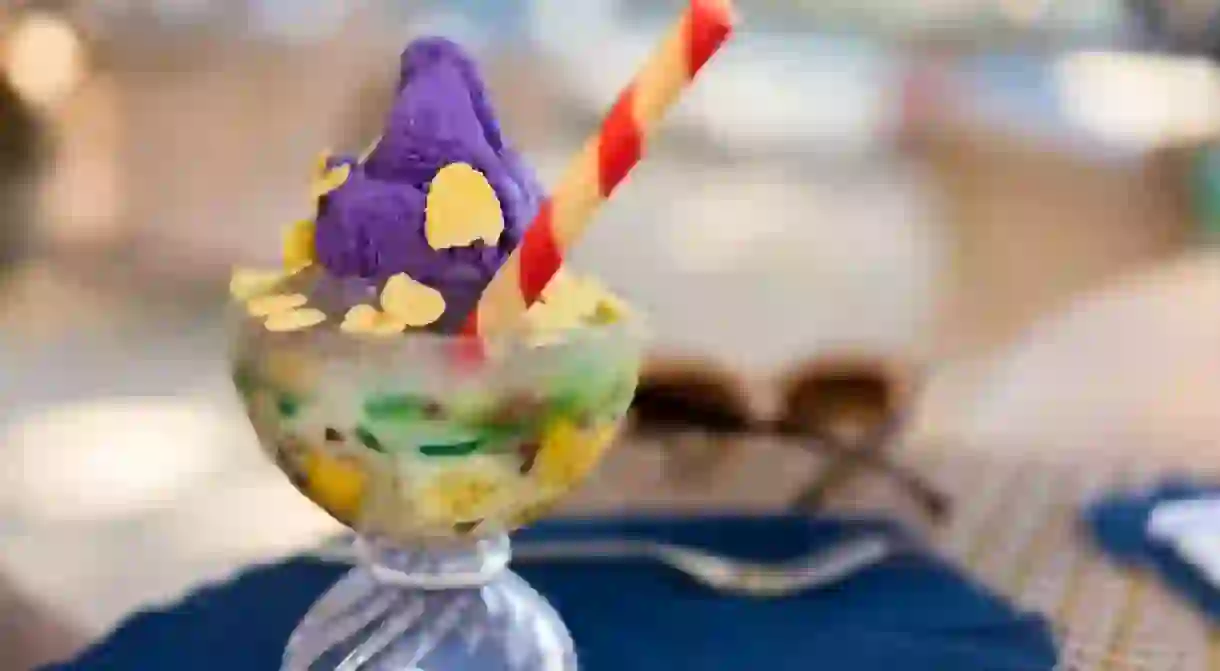Ube: The Philippine Purple Yam (More Popular Than Vanilla!)

For most Filipinos, no sweet concoction called halo-halo is ever complete without a scoop of the Philippine purple yam – more popularly known as ube (pronounced oo-beh). Native to the Philippines, ube has become more than just an add-on to the famous halo-halo but an essential, everyday ingredient that makes well-loved Filipino desserts and sweets extra special.
The history behind the Philippine purple yam

Dioscorea alata, the plant’s scientific name that bears ube, is indigenous to Asia, specifically grown in the Philippines. While most foreign people think that food color plays a role in its physical appearance, they’re often surprised to find out the process involved in preparing the purple yam.
Since the plant’s tubers are already vividly violet in color (hence, its name), all you need to do is add a few ingredients to turn the ube into a creamy dessert called ube jalea (ube jam) – the most common and simplest way to consume ube. However, no one knows how it became a constant, familiar dessert staple among Filipino families.
“There is no written documentation as to when Filipinos started using ube as a dessert,” says Felice Prudente Sta. Maria, a Filipino food historian who has been gathering histories and information about Filipino cuisine since the 1970s. According to Sta. Maria, the first Tagalog and Spanish dictionary published in 1613 mentioned ube (or uvi) as a type of camote (sweet potato) that belonged to the Convolvulaceae family. But later on, it was classified a yam, meaning it is of the Dioscorea family.
By the year 1918, the second earliest Philippine cookbook appeared and while it does not contain the ube jalea recipe, it included the procedure for jalea de calabaza (pumpkin jam). The procedure for such seemed to hint what may have been done for ube, says Sta. Maria. The process was to “cook it in water ’til it softens, mash until uniform in texture, add sugar mixed in water and cook over fire. Coconut milk can be added and cooked in also,” Sta. Maria adds.
How ube is prepared & consumed in the simplest way

While there is no known history as to when the Filipinos started transforming ube into ube jalea, it has been part of the childhood of most Filipinos – being served at town fiestas, birthdays, during Christmas, and other celebrations. Although everyone’s eating it like any other dessert, its simplicity and purple color stood out.
“By the 1960s, my uncle made ube jalea (or jalea de ube) in a huge kawa. He added condensed milk and butter instead of coconut milk. One had to stir and fold the mixture vigilantly so the sugar from the condensed milk would not burn,” Sta. Maria explains.
And once the mixture is thickened, you can finally transfer the mixture to a container and cool down to room temperature. Of course, it’s best served when chilled. Whatever ube jalea is paired with, it will surely please your palate.
Into the 1960s, there have been variations on how ube jalea has been presented. For instance, Sta. Maria says it was shaped into a hill on top of a bandejado (oval-shaped serving plate). Then, roses and other flowers with leaves scultep from the jalea were added atop – thus, making the dessert buffet “very lovely,” as Sta Maria describes.
Ube recipes and benefits

Apart from being a staple ingredient in the Filipinos’ favorite dessert called halo-halo, ube can also be used in other desserts such as cakes, flans, ice cream, cookies, spreads, crackers, and candies. According to Sta. Maria, the recipe for ube ice cream (using the “purple potato”) was published in 1922 wherein it combined mashed ube, milk, and sugar. During that time, ice cream was also hand-churned in a garapinyera – a manually operated ice cream mixer.
In 1989, a cookbook by Inday Gumban had a recipe for ube jubilee which is hard merengue with ube jalea between merengue layers. Sta. Maria says that Gumban’s cookbook also had recipes for ube ice cream and ube puto – a steamed sweet cake not served as a dessert but referred to as a breakfast and merienda (snack) food.
https://www.instagram.com/p/7VlGkvF8yC/?
As for ube’s benefits, the Philippine purple yam is generally a healthier alternative to regular yams because it has more antioxidants than regular ones. Thus, it’s said to help prevent DNA damage, cardiovascular diseases, and even cancer, according to a study conducted at Kansas University. Ube yams also contain Vitamin A, Vitamin C, Vitamin E, and high levels of potassium. And since it contains a lot of fiber, ube yams help foster a good environment for probiotic bacteria. Its vibrant purple color is also an indication that it contains lots of anthocyanins – a chemical that helps reverse cognitive and motor function decline (due to aging).













